#freshwater crustaceans
Explore tagged Tumblr posts
Text
A new crayfish has been described from the tributaries of the Warsamson River, in the Vogelkop Peninsula, of western Papua New Guinea. The 'new' crayfish species has received the name of Cherax warsamsonicus, the Warsamson River crayfish, although it was already known to aquarists and traded, as Cherax 'Irian Jaya', 'Hoa Creek', or 'Pink Coral'. Thus C. warsamsonicus is a good example of how discovery is not the same thing as formal, scientific description. The wild animals can have a total length of up to 11 centimeters, or a little above 4 inches.
Cherax are a genus of crayfishes or freshwater lobsters, that is endemic to the Australasian realm. The closest living relatives of the Australasian crayfishes are inhabitants of Madagascar and South America. Which is to say, a former distribution associated with Gondwana, whereas the other crayfishes are assumed to be a related, Laurasian group. The relationships between crayfish has often been used as evidence for continental drift, and the related biogeographic phenomenon, known as vicariance.
As a genus, Cherax is one of the most speciose genera of crayfishes, and is naturally present on both Australia and New Guinea. On Australia they are most commonly known as the yabbies, although the species called the marron, also belongs to this genus. However is is the New Guinea morphs of Cherax sp. that have more recently captivated the imaginations of aquarists, these morphs appearing in the trade before their formal descriptions.
C. warsamsonicus is described from a shallow, moderately flowing tributary of the Warsamson, though it is reportedly also found in the river itself. The water pH was around 6.5, the temperature was about 25 or 26 degrees centigrade. Reportedly they are also fairly omnivorous foragers, as you might expect of a Cherax species, although I do not have dietary information for this new species in the wild, beyond anecdotes that they are as easy to feed as are the other Cherax species.
Cherax sp. are omnivorous with a largely vegetarian bent, but they obtain animal protein through foraging activities, and not by active predation. Animals such as snails are consumed, and potentially sleeping fishes, but not vigorously motile animals. Other factors can lead to confrontations, when crayfish are housed with benthic fishes or crustaceans that use the living spaces within the aquarium. However in contrast with certain other crayfishes, Cherax sp. are less antisocial with their own kind, assuming that their environment allows each animal sufficient space and retreats.
Plants however, are very likely to be eaten by these herbivores, or if not, they could be uprooted by their ambulatory or burrowing activities. C. warsamsonicus excavate short burrows, but alternatively they hide themselves among rocks and pieces of detritus in the stream. Presumably they feed on vegetable detritus more than living plants in the wild, because there are few of the latter in the tributaries inhabited by C. warsamsonicus.
#Cherax warsamsonicus#Warsamson River crayfish#Cherax 'Irian Jaya'#Cherax 'Hoa Creek'#Cherax 'Pink Coral'#crayfishes#freshwater crustaceans#freshwater lobster
0 notes
Text

sneak peek of some new charms hitting the shop this weekend! unsure about the date yet but I’ll keep you all posted <3
3 cherry shrimp + one sexy shrimp, all super tiny and perfect for multitasking as a zipper pull 🦐
446 notes
·
View notes
Text

On a new species of vampire crab from the Geosesarma foxi species-group (Crustacea: Brachyura: Sesarmidae), northern Peninsular Malaysia
Peter K. L. Ng, S. Khadijah-Ahmad & Amirrudin B. Ahmad
Abstract:
Geosesarma bunian, new species, is described from Gunung Jerai in the northern Malaysian state of Kedah. Collected from over 1,100 m above sea level, the species is a member of the G. foxi (Kemp, 1918) species group, and is the fifth species known. Morphologically, G. bunian is closest to G. faustum Ng, 2017 from Penang, but the species can be distinguished by characters of the male first gonopod, male chelae and live coloration.
Read article here: RBZ-2025-0011
324 notes
·
View notes
Text

Pleistocene Fossil Freshwater Crab Preserved in Travertine - UV Reactive Calcite/Aragonite Specimen
#Pleistocene#travertine#crab#crab fossil#freshwater#fossil specimen#crabs#png#transparent#paleontology#paleoblr#prehistoric#crustacean#🦀
237 notes
·
View notes
Text
Wet Beast Wednesday: fairy shrimp
It's week 2 of fresh-uary, the month where I only cover freshwater species for Wet Beast Wednesday. This week's entry is on fairy shrimp, who are neither fairies nor shrimp. Instead, they are members of a mostly freshwater group of crustaceans called Branchipods. These little invertebrates are masters at surviving inhospitable conditions and one group has become famous in both the novelty pet and fish food worlds. You may know them as brine shrimp.
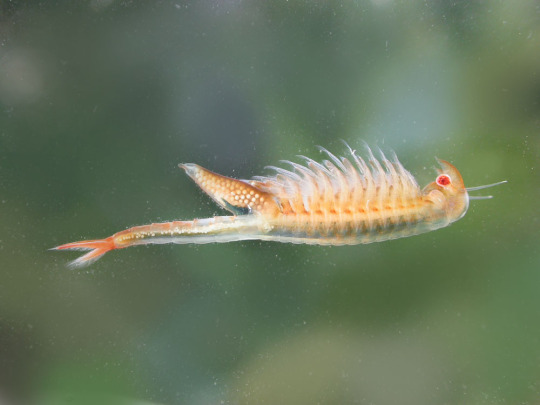
(Image: a female fairy shrimp. It is a small invertebrate somewhat shrimp-like in appearance. It has a large head with a compound eye and two pairs of antennae. The body is long and slender and the front half ans multiple limbs with feathery structures attached to them. The second half ends in a forked tail. This one has a short, transparent egg sac attached to its body just behind the limbs. Small, spherical eggs are visible within. End ID)
Fairy shrimp are members of the family Anostraca, with about 300 known species, many of which are found in very isolated areas. Most species are tiny, maxing out at 6 to 25 mm long, but some species get larger. The largest species, Branchinecta gigas, can reach 170 mm (6.7 in). Being crustaceans, they have exoskeletons, but fairy shrimp exoskeletons are very thin and fragile. The fairy shrimp body plan is divided into three regions, the head, thorax, and abdomen. The head has two compound eyes on stalks, the mouth, and two pairs of antennae. The first pair is long, thin, and unsegmented while the second pair differs depending on sex. Females have a second pair similar to the first pair, while the males have a second pair modified into grasping appendages used to hold onto the female during mating. The thorax is divided into multiple (usually 13 but sometimes more) segments. All but the final two segments are identical and each have a pair of feather-like appendages called phyllopods that act both as swimming limbs and gills. The final two segments of the thorax are fused and have a pair of appendages used for mating. The abdomen consists of 6 segments that don't have appendages. The final segment is the telson, which has a pair of paddle-like structures used for rapid movement and the anus.
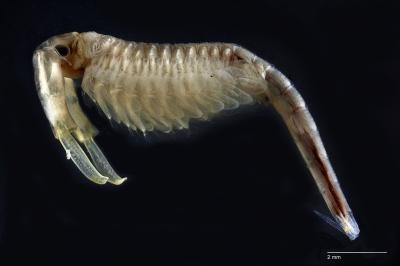
(Image: a male fairy shrimp, identifiable as such by the enlarged and leg-like second pair of antennae. End ID)
Fairy shrimp are graceful, but somewhat slow, swimmers who orient themselves belly-up and swim by moving their phyllopods in sequence. They primarily feed on algae, either by filter feeding or scraping it off of rocks and other submerged structures. Some of the larger species are predators of zooplankton and Branchinecta gigas is a hunter of smaller fairy shrimp. Fairy shrimp are found in inland water on all 7 continents. They specialize in seasonal pools and salt lakes. These harsh conditions make fairy shrimp experts as surviving where many other animals cannot. They have a high tolerance for salinity, heat, and low levels of oxygen, all of which help them survive in salt lakes and evaporating pools. A characteristic all fairy shrimp share is the ability for their eggs to enter a state called diapause. This is a form of cryptobiosis where the egg becomes a cyst that stops growth and metabolic activity. Their development effectively pauses until the proper conditions occur and biological activity resumes. Cysts can survive complete dessication, freezing, hypersaline conditions, UV radiation, and the vacuum of space and can remain in this condition for centuries. Diapause also helps the fairy shrimp spread, as their cysts can be carried to new habitat by the weather or other animals.
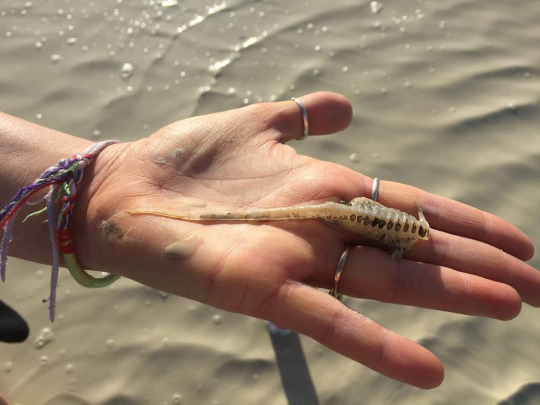
(Image: a giant fairy shrimp Branchinecta gigas held in somebody's hand to show off its size. It is longer than the person's finger and almost as thing in the thorax. End ID)
Fairy shrimp that live in seasonal pools live fast and die young. Their lifespans last a few months at most because they need to develop to maturity and reproduce before the pool dries up for the year. Most species of fairy shrimp have distinct sexes, but some species are exclusively female and reproduce through parthenogenesis. Males use their modified antennae to grab onto females and transfer sperm to her. The female will either carry her eggs on a sac attached to her abdomen or will maintain them internally. Eggs may be released to settle on the sediment or retained internally until the mother dies and sinks to the bottom. Some species will produce two types of eggs. Early season eggs are produced when water is still abundant in the pool. They will quickly hatch and mature to adulthood. Late season eggs are produced when the pool is drying up. They will settle to the sediment and become cysts, waiting for the next wet season to refill the pool before they hatch. Not all cysts will hatch each wet season, some will wait it out for later years. This ensures that a too-short wet season can't wipe out the whole population. Fairy shrimp living in salt lakes generally don't have to worry about their home drying out, but they maintain the ability to encyst their eggs in case the water gets too salty due to evaporation or too cold or hot. Fairy shrimp in salt lakes are vital to their environments because they regulate the population of phytoplankton and bacteria.
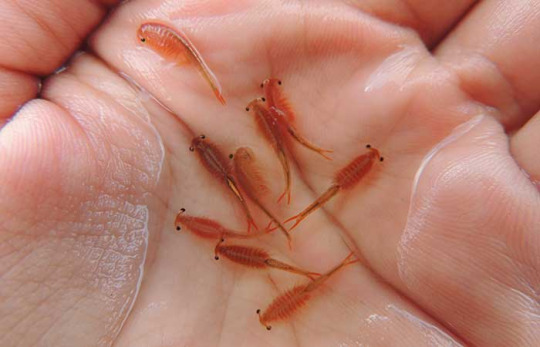
(Image: a close-up of somebody's hand holding some water and 9 red fairy shrimp. End ID)
Fairy shrimp are a major food source to many animals, especially birds. Their isolated or inhospitable habitats keep fairy shrimp safe from many predators, such as fish, but not from birds. Ducks and flamingos are some of the most prominent predators of fairy shrimp. Birds also help spread the shrimp, as the cysts can stick to their bodies or even pass through their digestive systems to be carried to other pools. Humans have also started using fairy shrimp as fish food in aquariums and aquaculture. There is now a multi-million dollar industry based around the Great Salt Lake in Utah and Mono Lake and San Fransisco Bay in California based around harvesting cysts and adult fairy shrimp for sale. The fairy shrimp used in aquaculture are almost all brine shrimp of the genus Artemia. Brine shrimp are also used as model organisms in science and as novelty pets under the brand name of sea monkeys. Brine shrimp cysts are easy to find in many pet and aquarium supply stores and will hatch quickly once exposed to water. Many wild fairy shrimp populations are threatened. Because of how isolated their pools can be, any damage to the pool can endanger the species. Pollution and habitat loss are threatening many species while human-caused movement of fairy shrimp cysts to new pools can lead to them harming native species.
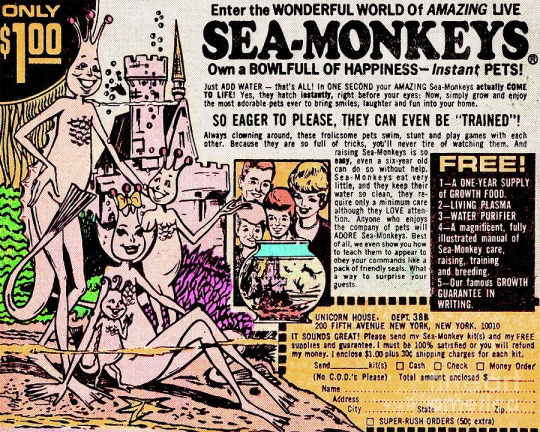
(Image: a magazine advertisement for sea monkeys, featuring a long text listing dubious facts about the animals, an order form, and an illustration of a nuclear family of anthropomorphic sea monkets that look like fish people with three antennae. End ID)
#wet beast wednesday#fairy shrimp#brine shrimp#sea monkeys#crustacean#arthropod#invertebrates#invertiblr#freshwater#freshwater ecology#ecology#zoology#biology#aquaculture#informative#educational#animal facts#image described
127 notes
·
View notes
Text
Uncharismatic Fact of the Day
What does a unicorn look like? Well for starters, it has six legs, two large claws, is bright purple...wait, no that's just the freshwater purple crab! Originally thought to be just one species, Insulamon unicorn, DNA analysis revealed that populations on other islands were in fact separate species, bringing the total number of Insulamon crabs up to 4.
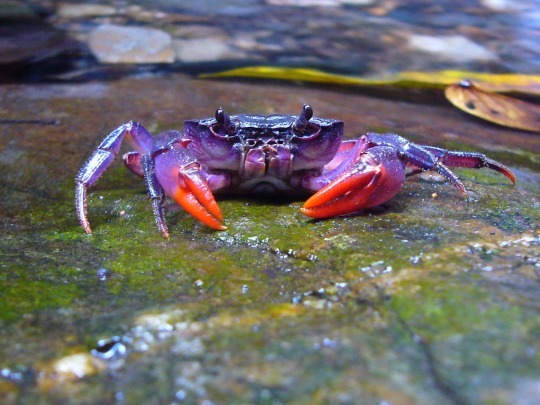
(Image: One of the new species of Insulamon crab, Insulamon palawanense, by Jolly Ibañez)
If you send me proof that you’ve made a donation to UNRWA or another organization benefiting Palestinians-- including esim donations-- I’ll make art of any animal of your choosing.
#Insulamon crabs#Decapoda#Potamidae#freshwater crabs#crabs#decapods#crustaceans#arthropods#uncharismatic facts
206 notes
·
View notes
Text


Ragu has been casting spells all day what do I do with them
#silly little guy#crayfish#virile crayfish#freshwater aquarium#freshwater biology#arthropods#crustacean#decapod#marine biology#keeperposting
43 notes
·
View notes
Text







Mommy crayfish and her baby crayfish <3
Korean Crayfish (Cambaroides similis)
#photographers on tumblr#my photography#original photographers#art#lensblr#photography#animal photography#wildlife photography#macro photography#nature photography#nature#wildlife#naturecore#crustacean#decapod#cambaroididae#crayfish#freshwater#freshwater fish#freshwater ecology#korea#korean#september 11 2024#no to generative ai
25 notes
·
View notes
Text

Big Sandy Crayfish
The Big Sandy, is a federally threatened species that is only found in the Big Sandy River basin in Virginia, Kentucky and West Virginia. And we have some pretty BIG, Big Sandy news.
For the first time ever, hatchery-reared Big Sandy crayfish have been released back into their native waters! Biologists recently released the first successful cohort — 77 crayfish — at multiple sites throughout Virginia's McClure River. This news is cray!
Photo by Brett Billings/USFWS
69 notes
·
View notes
Text
Lobsters start their life cycle as small shrimp in rivers, becoming crayfish as they mature and migrating to the sea in adulthood.
38 notes
·
View notes
Text
Most of the shrimp morphs favored by freshwater aquarium hobbyists, are Neocaridina sp. or other fan shrimps. However the South Asian species Macrobrachium agwi is very different. This is the striped 'prawn' or candy shrimp, or the dwarf or bumblebee large-armed shrimp, where 'large armed' is a translation of the genus name Macrobrachium. Before its formal description as a species, M. agwi was identified as a distinctive morph belonging to the genus, and traded as Macrobrachium sp. 'Banded'.
From the tips of their rostrums to the tips of their telsons, M. agwi are around 5 to 6 centimeters or 2 to 2 and a 1/3 inches long. The long claws are not included in this measurement, but they add significantly to the length of the animal, when they are in extended posture. Such a length is much smaller than that of some well known Macrobrachium species, and that is why M. agwi is sometimes traded with the name 'dwarf', although there are other small species among Macrobrachium.
M. agwi is a member of the successful and diverse genus Macrobrachium, to which a large number of species belong. Although it is customary to label Macrobrachium as prawns, many would argue that they are in actuality shrimps, although it is semantic. Also the genus Palaemon, although they are 'the' prawns on the British table, would also technically be shrimp using the same argument. In addition to their use in aquaria, a small number of Macrobrachium sp. are aqua cultured as food, primarily M. rosenbergi. Aquacultural interest in farming members of this genus has increased the knowledge base available for their aquarium care, though the focus is only on the large species that humans culture for food, not M. agwi.
When wild Macrobrachium sp. are exported for the aquarium trade, the exact species involved may be difficult to ascertain. Macrobrachium are mostly freshwater animals as adults, although some species in the genus are estuarine, and only one of these species is also faculatively marine. The planktonic larvae of a number of Macrobrachium species are exported out to sea downstream, therefore they possess tolerance of low salinity, before losing it, and later regaining the tolerance as late juveniles migrating upstream.
Many species of Macrobrachium thus require saltwater for their larval development, however M. agwi has abbreviated or direct development, and completes its entire life cycle in freshwater. M. agwi carries fewer and larger eggs than do some other freshwater Macrobrachium species, budgeting its energy into fewer offspring, with an abbreviated larval life after hatching. These larvae do not feed but continue to be sustained by the yolk donated by their mother. The development of their jointed appendages becomes accelerated, because these freshwater larvae are benthic and non-planktonic from the start.
In freshwater and some other environments, such a life history comes under positive selection, because the amount of plankton available as food for feeding larvae, is either consistently low, or is unpredictable. Such a life history has repeatedly evolved among the clade of shrimps, crabs, and lobsters. M. agwi and other fully 'freshwaterized' shrimp have broken completely with the habitat of their marine ancestors, and have also lost their physiological tolerance of saltwater at any of their life stages, because their ancestors had no further need to continue tolerating saline waters.
The species M. agwi was described from specimens collected at Barobisha, in the Alipurduar District of West Bengal but close to her border with Assam. The climate of Alipurduar is monsoon-influenced and shows variation over the year, from an air temperature of 14 degrees centigrade in the coolest month, to 34 degrees in the warmest month. The water of the Kaljani, the river of Alipurduar, usually has a pH between 7 and 8, sometimes a little higher or lower, but circumneutral and shifted towards baseness.
The water temperature there may vary according to the month, with monthly temperatures as low as 10 and as high as 32 degrees. In neighboring Koch Berar, the main river is the Torsa and the climate is similar to that of Alipurduar. The water temperature of the River Torsa was found to vary from 18 to 29 degrees, and the pH is similar to that of the River Kaljani. There is no major river through Barobisha itself, but the neighboring waters assumedly have comparable parameters. Streams in neighboring western Assam can have a pH of 6.4 to 6.6.
Macrobrachium are regarded as omnivorous benthivores, or generalists feeding on a breadth of plants and animals on the substrate. Although plant material is taken, Macrobrachium show a preference for animal protein. Although their 'arms' are long, their 'claws' are proportionally small, thus limiting the damage these shrimp are capable of in the aquarium. Smaller species of Macrobrachium are often considered safe to cohabit with some fish, although fish eggs and small motile animals such as small fish, will likely be seen as food by these shrimps, and they will certainly consume snails. Juveniles of large Macrobrachium species, can kill and consume snails with a shell diameter almost 3/4 of their own length.
Smaller Macrobrachium species will not kill fish their own size, but the larger species of the genus are reportedly able to. Eggs and fry of fishes, and the larvae of other shrimps, will likely be eaten even by the small species of Macrobrachium. Macrobrachium species appear to vary in their intraspecific competitiveness and tendencies towards cannibalism, but each individual requires a sufficient number of opportunities in the aquascape, in which to choose shelter from cohabiting conspecifics. Therefore, although M. agwi can be housed in small groups of conspecifics, they must not be overcrowded, each animal must be able to avoid confrontation, and also retreat to shed whilst they are growing, without facing competition for these refuges.
In some Macrobrachium species, molting shrimp may be vulnerable to cannibalism, whilst they are still soft. Confrontations in members of this genus, can also result in the loss of whole or partial limbs, or other severe damage. Therefore it is important to avoid these animals stressing one another. Smaller Macrobrachium species do not uproot or otherwise seriously disturb plants in the aquascape, although the larger species in the genus can be destructive, especially to delicate plants. In anecdotes from the tropical aquarium trade, these shrimp are often kept in water with a circumneutral pH, and at an appropriate temperature of 18 to 26 degrees centigrade, befitting their origins close to the Himalayas.
#Macrobrachium agwi#candy shrimp#striped prawn#large-armed shrimp#freshwater crustaceans#Macrobrachium sp. banded#dwarf large-armed shrimp#bumblebee large-armed shrimp
1 note
·
View note
Text
Just a reminder to join our silly Lake Love community if you want 💙🌊. It's moderated often to limit spam and there are lots of lovely nature pics and funny science memes 🐙
#communities#community#tumblr communities#lake love#lakes#oceans#science#ecology#wetlands#crustaceans#fish#limnology#marine biology#freshwater ecology#nature
6 notes
·
View notes
Text
Hycia’s Next Big Step!


As I’ve continued to work hard on developing my card game, Hycia, I managed to reach a big milestone this past week. As you can see, I finally have a printed beta for the entire game, ready to work with and do some playtesting!
In the time since this package arrived I’ve already been able to gather a lot of useful information, including being able to host a big playtesting session. I hope this all helps to show anybody that I’m completely dedicated to making this project as great as it can possibly be!
I had taken a months-long hiatus to work behind-the-scenes on getting this thing printed as quickly as possible, but I’ll be returning to my regularly scheduled “4 new characters per week” as I used to do starting next Friday. I’ll be considering posting more consistently here on Tumblr on Hycia’s progress, but if you want to support this game’s production and future (or just want to learn more about it) please considering checking out these social links down below: there’s a lot more history and info to uncover there.


Website: https://www.hyciahub.com
Twitter/X: https://lnkd.in/dpQkqT6r
Instagram: https://lnkd.in/dN9bQxN4
Bluesky: https://lnkd.in/dR4vE8tS
Discord: https://lnkd.in/d9CpJQ_q
#hyciacardgame#hycia#card game#marine biology#card game design#kickstarter campaign#crowdfunding#fish#cetaceans#cephalopods#freshwater fish#crustacean#sharing appreciated
12 notes
·
View notes
Text
BEHOLD THE SHRIMP
Got some Neocaridina shrimpies and some nerite snails for my new freshwater tank and OH MY GOD THEYRE SO CUTE
#crustacean#crustaceous#shrimp#freshwater aquarium#planted aquarium#planted tank#aquascape#aquarium#neocaridina#cherry shrimp#nerite snail#snailblr#mollusk#creature#creatures#pets of tumblr#pets
25 notes
·
View notes
Text
#2586 - Paranephrops planifrons - Northern Koura

One of Aotearoa's two endemic freshwater crayfish - this one is most common on the North Island, and along the West Coast of South Island. Both Paranephrops are important resources to the indigenous Māori, and surprisingly given the troubles facing every second species I've covered lately, are not considered treatened.
Parastacid crayfish are found only in the Southern Hemisphere, with extant members in South America, Madagascar, Australia, New Zealand, and New Guinea, and extinct taxa in Antarctica - a classic Gondwanan distribution. They're most diverse in Australia.
Hokitika National Kiwi Centre, Aotearoa New Zealand
7 notes
·
View notes
Text
Wet Beast Wednesday: crayfish
It's week 3 of fresh-uary, the month where I only cover freshwater species for Wet Beast Wednesday. This week's topic is the crayfish, also known as the crawfish, crawdad, mudbug, lobster, yabby, kōura, and a lot of other names. The various names for crayfish are also applied to a variety of saltwater species that aren't the topic of today's post, so there's some confusion over terminology when discussing these creatures. Let me clear some of that up and explain why it's ok to be cray.
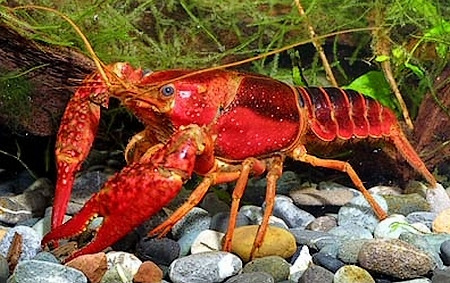
(Image: a red swamp crayfish (Procambarus clarkii), seen from the side. It is a long, lobster-like crustacean with a rigid front half and flexible tail ending in a wide fan. It walks on 8 legs and has a large pair of pincers held in front of the body. The head ends in a pointy snout with two eyes on short stalks and two pairs of antennae. This one is mostly red, with darker portions on the back. End ID)
The crayfish I'm covering today are freshwater members of the clade Astacidea. This clade also contains clawed lobsters, so there is a lot of similarity between the two groups. There are four families of crayfish, split between two superfamilies. These families are largely split up by region. The superfamily Astacoidea are known as northern hemisphere crayfish and contains the families Cambaroididae (found in eastern Asia), Astacidae (found in west Asia, Europe, and Western North America), and Cambaridae (found in eastern North America). The superfamily Parastacoidea, or southern hemisphere crayfish, contains the family Parastacidae, members of which live (or used to live) in South America, Madagascar, and Australia and New Zealand.
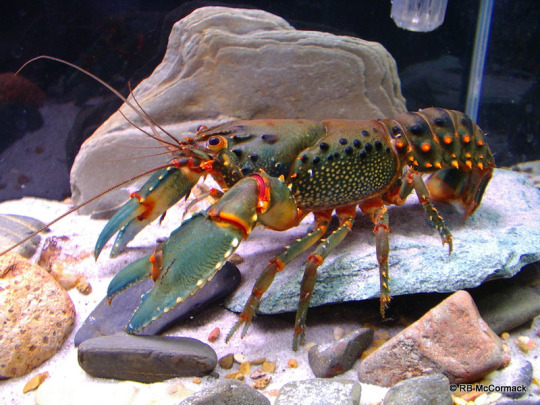
(Image: The Sydney spiny crayfish (Euastacus spinifer) seen from the side. It is a dark green in color, with orange outlines and orange and black spines around the body. End ID)
Crayfish are very similar to clawed lobsters in appearance and have a fairly typical decapod body plan. Their bodies consist of 20 segments grouped into two main body parts: the cephalothorax and abdomen. The cephalothorax is rigid, covered by the carapace, and contains the head and attachments for the legs. The head includes two stalked eyes, two sets of antennae, and a sideways opening mouth surrounded by leg-like maxillipeds that help manipulate food. As a decapod, crayfish have 10 legs. Like their clawed lobster cousins, crayfish use four pairs for walking while the front pair have been modified into a pair of large pincers used for defense and capturing food. Lost limbs can be regrown, though it takes a while. The abdomen forms the flexible "tail". Each segment of the abdomen contains a pair of appendages called pleopods or swimmeretes. These help circulate water and can be used to swim in juveniles. In males, the first pair of pleopods is modified into grasping structures used to hold onto the female during mating. The abdomen ends with a fan-like structure called the telson, that acts like a fin. By rapidly curling its abdomen beneath it, a crayfish can shoot backwards away from danger. The largest species of crayfish, and largest freshwater invertebrate, is Astacopsis gouldi, the giant Tasmanian freshwater crayfish. It can reach 80 cm (31 in) long and 6 kg (13 lbs), though such large individuals are rare. Most crayfish species are considerably smaller.
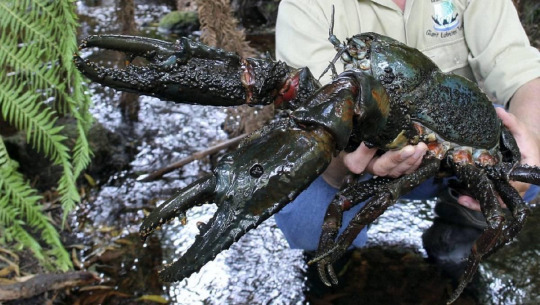
(Image: someone holding a giant Tasmanian crayfish up to the camera. It is extremely large for a crayfish, requiring two hands to hold and its pincers are roughly as long as the person's hands. It is a dark, swampy green to black in color, with many small lumps on the body. End ID)
Crayfish are benthic omnivores and detritovores found in both running and still water. Crayfish are opportunistic feeders with extremely varied diets that include plants, fungi, animals, microorganisms, and decaying organic matter. Mist species are considered primarily herbivorous and scavengers, though they will take live prey if the opportunity arises and have been known to be cannibalistic. Decomposing organic matter forms a large portion of the crayfish diet and they often eat it through the mud and slime found on the bottom of their habitats. A crayfish can quickly swallow mud, then internally sort it by the size of ingested particles. Coarser materials are processed and excreted faster. The digestive tract can process the dead plankton and decaying organic matter that makes up mud from the sediment. Feces are excreted wrapped in a peritrophic membrane. This membrane is rich in proteins and is usually eaten by the crayfish to regain them and get a second shot at digesting organic matter in the feces. Fresh vegetation is also a major food source and there are even reports of crayfish leaving the water to graze on land plants. Crayfish feed periodically, switching between periods of feeding and periods of hiding while they digest. As with all crustaceans, crayfish have to regularly molt their exoskeletons as they grow. They typically eat their old carapaces to regain the calcium carbonate and other molecules contained in the shell. After molting, it takes time for the new exoskeleton to harden, leaving the crayfish more vulnerable to injury or predation.

(Image: a small, orange crayfish in captivity inspecting a cucumber slice that is being offered as food. End ID)
Crayfish mate seasonally, usually in spring through late summer, triggered by changes in water temperature. The exact mating process depends on species, though females are likely to release pheromones to attract males. Males are initially aggressive, but often calm down sometime before mating. Males are known to fight over access to females. In some species, the male and female will touch claws and exchange chemical signatures prior to mating possibly as a courtship ritual. Males have also been seen attempting to mate with other males. Once a female accepts a mate, the male will flip her onto her back and align their abdomens, using his modified first pair of pleopods to grab on. Once their genitals are aligned, the male will pass a sac of sperm to the female using structures called gonopods. The male will leave after mating. The female lays clusters of eggs that are carefully attached to the pleopods. Until the eggs hatch, the mother will carry them with her, moving her pleopods to circulate water around them and using her legs to clean them. Egg development can takes days to weeks depending on species. The young are born well developed for crustaceans, looking like miniature adults. The female will shake her pleopods to help the hatchlings emerge. Juveniles are at a high risk of predation, including from other crayfish, so only a few of the possible hundreds of eggs will reach adulthood. It can take years for a crayfish to reach sexual maturity.
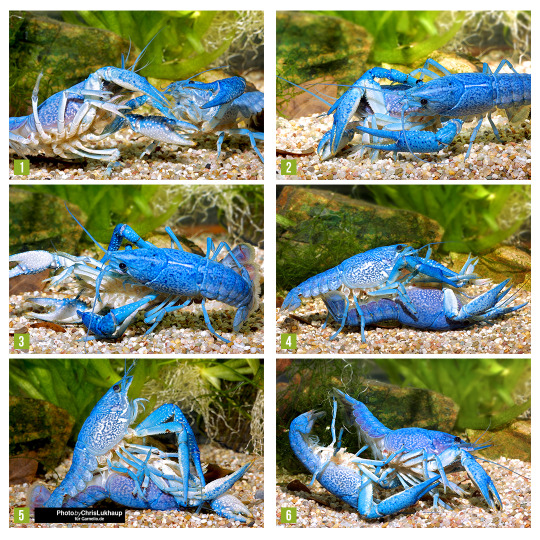
(Image: a series of 6 photos showing two blue crayfish mating. In the first three photos, the male turns the female on her back. In the 4th photo, the male starts to line up his abdomen with hers. In the 5th photo, the abdomens are aligned and mating is occurring. In the last photo, the male climbs off of the female. End ID. Source)

(Image: a female crayfish being held upside down to show her eggs, visible as small, black balls attached to the underside of the abdomen. End ID)
Crayfish are edible and eaten worldwide, with 95% of the world supply coming from China. Boiling is the most common form of cooking. Experiments have shown that crayfish take a while to die when boiled and show pain responses. They also release cortisol, a stress hormone, when boiled. There is, for some reason, a debate on whether or not crustaceans can feel pain. I think that it's obvious they have negative responses to negative stimuli and therefore it can be safely assumed that they can suffer. To more humanely cook a crayfish, freeze them for a few hours to render them unconscious, then cut down the body lengthwise to destroy the nervous system before boiling. Crayfish are also kept in aquariums as pets and can be fed shrimp pellets and plants, but they may also try to eat other organisms in the same tanks. In the wild, many species of crayfish are threatened by overfishing, habitat loss, climate change, and pollution. Most species need clean water and are highly vulnerable to pollutants. This allows crayfish to be used as an indicator species for the health of their environments. The pseudofungus Aphanomyces astaci causes a fatal disease called crayfish plague that has escaped from aquacultures to affect wild populations. Side note, I had no idea pseudofungi were a thing until right now. Multiple species of crayfish have become invasive species after accidental or intentional release of common food species. Other invasive species can outcompete or prey on native species.
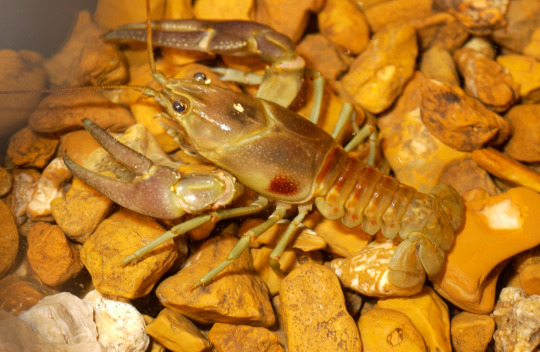
(Image: the rusty crayfish (Faxonius rusticus), a common invasive species in North America, identifiable by the rust-red blotch located on the sides of the carapace near the rear of the cephalothorax. End ID)
#wet beast wednesday#crayfish#crawfish#crawdad#yabby#yabbies#kōura#mudbug#graphic crayfish sex#crustacean#invertebrates#invertiblr#freshwater#claws#ecology#biology#zoology#animal facts#informative#educational#image described
86 notes
·
View notes